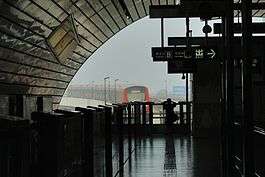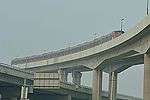Fangshan line
The Fangshan Line of the Beijing Subway (Chinese: 北京地铁房山线; pinyin: běijīng dìtiě fángshān xiàn) is a rapid transit line in western Beijing that runs from Yancun East in Fangshan District north and east to Guogongzhuang in Fengtai District. The line is 27 km (17 mi) long, has 12 stations. It is mainly elevated, including 10 elevated stations and 2 underground stations.[2] It allows residents of Beijing's western suburbs to connect to the rest of the Beijing Subway network. It was opened on December 30, 2010.
| Fangshan line | |||||||||||||||||||||||||||||||||||||||||||||||||||||||||||||||||||||||||||||||||||||||||||||||||||||||||||||||||||||||||||||||||||||||||||||||||||||||||||||||||||||||||||||||||||||||||||||||||||||||||||||||||||||||||||||||||||||||||||||||||||||||||||||||||||||||||||||||||||||||||||||||||||||||||||||||||||
|---|---|---|---|---|---|---|---|---|---|---|---|---|---|---|---|---|---|---|---|---|---|---|---|---|---|---|---|---|---|---|---|---|---|---|---|---|---|---|---|---|---|---|---|---|---|---|---|---|---|---|---|---|---|---|---|---|---|---|---|---|---|---|---|---|---|---|---|---|---|---|---|---|---|---|---|---|---|---|---|---|---|---|---|---|---|---|---|---|---|---|---|---|---|---|---|---|---|---|---|---|---|---|---|---|---|---|---|---|---|---|---|---|---|---|---|---|---|---|---|---|---|---|---|---|---|---|---|---|---|---|---|---|---|---|---|---|---|---|---|---|---|---|---|---|---|---|---|---|---|---|---|---|---|---|---|---|---|---|---|---|---|---|---|---|---|---|---|---|---|---|---|---|---|---|---|---|---|---|---|---|---|---|---|---|---|---|---|---|---|---|---|---|---|---|---|---|---|---|---|---|---|---|---|---|---|---|---|---|---|---|---|---|---|---|---|---|---|---|---|---|---|---|---|---|---|---|---|---|---|---|---|---|---|---|---|---|---|---|---|---|---|---|---|---|---|---|---|---|---|---|---|---|---|---|---|---|---|---|---|---|---|---|---|---|---|---|---|---|---|---|---|---|---|---|---|---|---|---|---|---|---|---|---|---|---|---|---|---|---|---|---|---|---|---|---|---|---|---|---|---|---|---|---|---|---|---|---|
| Fangshan | |||||||||||||||||||||||||||||||||||||||||||||||||||||||||||||||||||||||||||||||||||||||||||||||||||||||||||||||||||||||||||||||||||||||||||||||||||||||||||||||||||||||||||||||||||||||||||||||||||||||||||||||||||||||||||||||||||||||||||||||||||||||||||||||||||||||||||||||||||||||||||||||||||||||||||||||||||
 Fangshan Line train entering Changyang Station. | |||||||||||||||||||||||||||||||||||||||||||||||||||||||||||||||||||||||||||||||||||||||||||||||||||||||||||||||||||||||||||||||||||||||||||||||||||||||||||||||||||||||||||||||||||||||||||||||||||||||||||||||||||||||||||||||||||||||||||||||||||||||||||||||||||||||||||||||||||||||||||||||||||||||||||||||||||
| Overview | |||||||||||||||||||||||||||||||||||||||||||||||||||||||||||||||||||||||||||||||||||||||||||||||||||||||||||||||||||||||||||||||||||||||||||||||||||||||||||||||||||||||||||||||||||||||||||||||||||||||||||||||||||||||||||||||||||||||||||||||||||||||||||||||||||||||||||||||||||||||||||||||||||||||||||||||||||
| Other name(s) | M25 North (planned name) Line 25 North | ||||||||||||||||||||||||||||||||||||||||||||||||||||||||||||||||||||||||||||||||||||||||||||||||||||||||||||||||||||||||||||||||||||||||||||||||||||||||||||||||||||||||||||||||||||||||||||||||||||||||||||||||||||||||||||||||||||||||||||||||||||||||||||||||||||||||||||||||||||||||||||||||||||||||||||||||||
| Type | Rapid transit | ||||||||||||||||||||||||||||||||||||||||||||||||||||||||||||||||||||||||||||||||||||||||||||||||||||||||||||||||||||||||||||||||||||||||||||||||||||||||||||||||||||||||||||||||||||||||||||||||||||||||||||||||||||||||||||||||||||||||||||||||||||||||||||||||||||||||||||||||||||||||||||||||||||||||||||||||||
| System | Beijing Subway | ||||||||||||||||||||||||||||||||||||||||||||||||||||||||||||||||||||||||||||||||||||||||||||||||||||||||||||||||||||||||||||||||||||||||||||||||||||||||||||||||||||||||||||||||||||||||||||||||||||||||||||||||||||||||||||||||||||||||||||||||||||||||||||||||||||||||||||||||||||||||||||||||||||||||||||||||||
| Status | Operational | ||||||||||||||||||||||||||||||||||||||||||||||||||||||||||||||||||||||||||||||||||||||||||||||||||||||||||||||||||||||||||||||||||||||||||||||||||||||||||||||||||||||||||||||||||||||||||||||||||||||||||||||||||||||||||||||||||||||||||||||||||||||||||||||||||||||||||||||||||||||||||||||||||||||||||||||||||
| Locale | Fengtai and Fangshan districts Beijing | ||||||||||||||||||||||||||||||||||||||||||||||||||||||||||||||||||||||||||||||||||||||||||||||||||||||||||||||||||||||||||||||||||||||||||||||||||||||||||||||||||||||||||||||||||||||||||||||||||||||||||||||||||||||||||||||||||||||||||||||||||||||||||||||||||||||||||||||||||||||||||||||||||||||||||||||||||
| Termini | Yancun East Guogongzhuang | ||||||||||||||||||||||||||||||||||||||||||||||||||||||||||||||||||||||||||||||||||||||||||||||||||||||||||||||||||||||||||||||||||||||||||||||||||||||||||||||||||||||||||||||||||||||||||||||||||||||||||||||||||||||||||||||||||||||||||||||||||||||||||||||||||||||||||||||||||||||||||||||||||||||||||||||||||
| Stations | 12 | ||||||||||||||||||||||||||||||||||||||||||||||||||||||||||||||||||||||||||||||||||||||||||||||||||||||||||||||||||||||||||||||||||||||||||||||||||||||||||||||||||||||||||||||||||||||||||||||||||||||||||||||||||||||||||||||||||||||||||||||||||||||||||||||||||||||||||||||||||||||||||||||||||||||||||||||||||
| Daily ridership | 102,600 (2014 Avg.) 132,100 (2014 Peak)[1] | ||||||||||||||||||||||||||||||||||||||||||||||||||||||||||||||||||||||||||||||||||||||||||||||||||||||||||||||||||||||||||||||||||||||||||||||||||||||||||||||||||||||||||||||||||||||||||||||||||||||||||||||||||||||||||||||||||||||||||||||||||||||||||||||||||||||||||||||||||||||||||||||||||||||||||||||||||
| Operation | |||||||||||||||||||||||||||||||||||||||||||||||||||||||||||||||||||||||||||||||||||||||||||||||||||||||||||||||||||||||||||||||||||||||||||||||||||||||||||||||||||||||||||||||||||||||||||||||||||||||||||||||||||||||||||||||||||||||||||||||||||||||||||||||||||||||||||||||||||||||||||||||||||||||||||||||||||
| Opened | 30 December 2010 | ||||||||||||||||||||||||||||||||||||||||||||||||||||||||||||||||||||||||||||||||||||||||||||||||||||||||||||||||||||||||||||||||||||||||||||||||||||||||||||||||||||||||||||||||||||||||||||||||||||||||||||||||||||||||||||||||||||||||||||||||||||||||||||||||||||||||||||||||||||||||||||||||||||||||||||||||||
| Operator(s) | Beijing Mass Transit Railway Operation Corp., Ltd | ||||||||||||||||||||||||||||||||||||||||||||||||||||||||||||||||||||||||||||||||||||||||||||||||||||||||||||||||||||||||||||||||||||||||||||||||||||||||||||||||||||||||||||||||||||||||||||||||||||||||||||||||||||||||||||||||||||||||||||||||||||||||||||||||||||||||||||||||||||||||||||||||||||||||||||||||||
| Depot(s) | Yancun | ||||||||||||||||||||||||||||||||||||||||||||||||||||||||||||||||||||||||||||||||||||||||||||||||||||||||||||||||||||||||||||||||||||||||||||||||||||||||||||||||||||||||||||||||||||||||||||||||||||||||||||||||||||||||||||||||||||||||||||||||||||||||||||||||||||||||||||||||||||||||||||||||||||||||||||||||||
| Rolling stock | 6-car Type B (BD24) | ||||||||||||||||||||||||||||||||||||||||||||||||||||||||||||||||||||||||||||||||||||||||||||||||||||||||||||||||||||||||||||||||||||||||||||||||||||||||||||||||||||||||||||||||||||||||||||||||||||||||||||||||||||||||||||||||||||||||||||||||||||||||||||||||||||||||||||||||||||||||||||||||||||||||||||||||||
| Technical | |||||||||||||||||||||||||||||||||||||||||||||||||||||||||||||||||||||||||||||||||||||||||||||||||||||||||||||||||||||||||||||||||||||||||||||||||||||||||||||||||||||||||||||||||||||||||||||||||||||||||||||||||||||||||||||||||||||||||||||||||||||||||||||||||||||||||||||||||||||||||||||||||||||||||||||||||||
| Line length | 27 km (17 mi) | ||||||||||||||||||||||||||||||||||||||||||||||||||||||||||||||||||||||||||||||||||||||||||||||||||||||||||||||||||||||||||||||||||||||||||||||||||||||||||||||||||||||||||||||||||||||||||||||||||||||||||||||||||||||||||||||||||||||||||||||||||||||||||||||||||||||||||||||||||||||||||||||||||||||||||||||||||
| Track gauge | 1,435 mm (4 ft 8 1⁄2 in) | ||||||||||||||||||||||||||||||||||||||||||||||||||||||||||||||||||||||||||||||||||||||||||||||||||||||||||||||||||||||||||||||||||||||||||||||||||||||||||||||||||||||||||||||||||||||||||||||||||||||||||||||||||||||||||||||||||||||||||||||||||||||||||||||||||||||||||||||||||||||||||||||||||||||||||||||||||
| |||||||||||||||||||||||||||||||||||||||||||||||||||||||||||||||||||||||||||||||||||||||||||||||||||||||||||||||||||||||||||||||||||||||||||||||||||||||||||||||||||||||||||||||||||||||||||||||||||||||||||||||||||||||||||||||||||||||||||||||||||||||||||||||||||||||||||||||||||||||||||||||||||||||||||||||||||
The most recent expansion of the line came on December 30, 2017 with the opening of the one-station western extension to Yancun East.
The line will be extended further north to the southwest corner of the Third Ring Road, and will connect with Line 10 at Shoujingmao and with Line 16 at Fengyiqiao South. The northern extension will open in late 2020.[3]
Route

The Fangshan Line starts at Yancun East, just west of the East Yancun Bridge, where it interchanges with the Yanfang Line. Previously, it started at Suzhuang which is located at the intersection of Changhong Xi Lu and Suzhuang Dajie in the Liangxiang area of Fangshan District. The line makes four stops in Liangxiang including at the Fangshan Campus of the Beijing Institute of Technology. The line then heads north to the towns of Guangyang and Changyang. After crossing the Yongding River, the Fangshan Line enters Fengtai District where the line makes its two most northern stops, at Dabaotai near the Beijing World Park, and at Guogongzhuang, also the southern terminus of Line 9.
Stations
List of stations from northeast to southwest:
| Station Name | Connections | Nearby Bus Stops | Distance km[4] |
Location | ||
|---|---|---|---|---|---|---|
| English | Chinese | |||||
| Fengyiqiao South | 丰益桥南 | 16 | Fengtai | |||
| Shoujingmao | 首经贸 | 10 | ||||
| Sihuanlu | 四环路 | |||||
| Fanyanglu | 樊羊路 | |||||
| Guogongzhuang | 郭公庄 | 9 | 470 497 627 969 | 0.000 | 0.000 | |
| Dabaotai | 大葆台 | 480 840 912 967 | 1.405 | 1.405 | ||
| Daotian | 稻田 | 391 832 | 6.466 | 7.871 | Fangshan | |
| Changyang | 长阳 | 646 832 912 956 993 专93 专94 | 4.041 | 11.912 | ||
| Libafang | 篱笆房 | 646 907 912 951 993 专92 | 2.150 | 14.062 | ||
| Guangyangcheng | 广阳城 | 956 | 1.474 | 15.536 | ||
| Liangxiang University Town North | 良乡大学城北 | 2.003 | 17.539 | |||
| Liangxiang University Town | 良乡大学城 | 896 934 | 1.188 | 18.727 | ||
| Liangxiang University Town West | 良乡大学城西 | 895 | 1.738 | 20.465 | ||
| Liangxiangnanguan | 良乡南关 | 833 895 897 956 | 1.332 | 21.797 | ||
| Suzhuang | 苏庄 | 833 897 907 934 993 | 1.330 | 23.127 | ||
| Yancun East | 阎村东 | Yanfang | 2.200[4] | 25.327 | ||
History
Construction of the Fangshan Line was originally set to begin in 2012[5] but was moved up to April 1, 2009 to use stimulus funding provided by the government to counter the Financial Crisis of 2007-08.[6] The names of Phase 1 stations was announced on March 25, 2010 as a 7-day publicity.[7]
On December 30, 2010, the line began operating from Suzhuang to Dabaotai, but was not connected to any other line of the subway system. One year later, on December 31, 2011, the Dabaotai to Guogongzhuang section opened, linking the Fangshan Line with Line 9 and the rest of the subway network.
| Segment | Commencement | Length | Station(s) | Name |
|---|---|---|---|---|
| Dabaotai — Suzhuang | 30 December 2010 | 24.79 km (15.4 mi)[8] | 10 | Phase 1 |
| Guogongzhuang — Dabaotai | 31 December 2011 | 1 | ||
| Suzhuang — Yancun East | 30 December 2017 | 2.2 km (1.4 mi)[9] | 1 | Western extension |
Future Expansion
From Guogongzhuang, where the line currently terminates, the Fangshan line will be extended further to the northeast for 5.25 km (3.26 mi)[10] to the southwest corner of the Third Ring Road.[11] The extension is fully underground.[11] The line will have four additional stations—Fanyanglu (樊羊路), Sihuanlu (四环路), Shoujingmao (Capital University of Economics and Business) (首经贸) and Fengyiqiao South (丰益桥南),[11] and will connect with Line 10 at Shoujingmao and with Line 16 at Fengyiqiao South.[12] The northern extension will open in late 2020.[3]
Rolling Stock
| Model | Image | Manufacturer | Year Built | Amount in Service | Fleet Numbers | Depot |
|---|---|---|---|---|---|---|
| BD24 |  |
Beijing Subway Rolling Stock Equipment | 2009, 2019–2020 | 34 | FS 001–FS 026, FS 028–FS 031, FS 033–FS 036 | Yancun |
References
| Wikimedia Commons has media related to Fangshan Line, Beijing Subway. |
- 2014年4月30日综合交通总体运行情况. 北京市交通信息中心 北京市交通运行监测调度中心. 2014-05-01. Archived from the original on 2014-05-02. Retrieved 2014-05-02.
- 北京地铁房山线规划方案公布 设车站11座 Mar. 24, 2010 (Chinese)
- "房山线北延阎村车辆段(新扩建区域)冷、热滑试验完成". 2019-09-06.
- "房山线路网车站站间距信息". Retrieved 2020-04-29.
- "北京轨道交通房山线提前至年内开工", 北京晨报 June 29, 2008 (Chinese)
- "地铁房山线11座站名确定" 京华时报 Archived 2010-10-01 at the Wayback Machine Jan. 7, 2009 (Chinese)
- http://3g.163.com/news/article/62MII1VA000146BD.html
- "房山线北延四站明年开工".
北起丰台区郭公庄站,南至房山区苏庄站。全长24.79公里,设11座车站
- "全自动、磁浮、有轨电车 北京宣布开通三条轨道交通新线". 2017-12-29.
30日还将开通房山线阎村东至苏庄的一站一区间,长度约2.2公里
- "北京轨道交通房山线北延四环路站通过结构验收". 2018-03-12.
- "房山线将延伸"牵手"多条地铁". 2015-11-19.
- Liang Qi (梁琦) (2014-03-01). 房山线北延 衔接16号线 (in Chinese). Beijing Youth Daily.